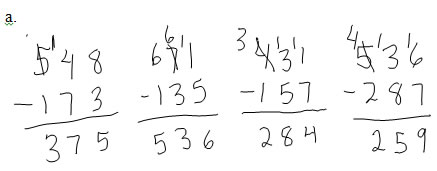

Tips and answers (work in progress)
Questions you should know how to answer and that are reasonably likely to appear on the exam:
1. Give examples of groupable/decomposable base 10 materials, pre-grouped proportional and pregrouped non-proportional base 10 materials. Tell what the advantages are of each kind of material. (lesson 3.1)
2. Give some advantages of teaching 2-digit addition by questioning and discussing (lesson 3.2)
3. Give some advantages of teaching 2-digit addition by demonstrating and explaining (lesson 3.3)
4. Explain in words the steps in the standard algorithm (lessons 3.4 and 3.5) for
a. 263 + 182
b. 328 - 192
lesson 3.7:
5. Show how to compute 385 + 279 using:
a. the the expanded algorithm
b. the British algorithm
6. Show how to compute 48 + 24 using:
a. adding on in chunks using the place values of one addend
b. adding on in chunks using multiples of 10 as bridge numbers
c. finding friendly numbers and compensating at the end
d. finding friendly numbers and compensating between the addends
e. breaking both numbers into place value and adding within place values.
7. Show how to compute 623 - 184 using
a. the equal additions algorithm.
b. taking away in chunks using place values of the subtrahend
8. Explain how the trade-first algorithm is different from the standard algorithm for subtraction.
9. Show how to compute 83 - 26 using:
a. Adding up in chunks using multiples of 10 as bridge numbers
b. Place value and negative numbers
c. Adjusting to friendly numbers and compensating at the end
d. Adjusting to friendly numbers by changing both number to keep the same difference (shifting the number line)
e. Breaking into place values and exchanging (expanded subtraction)
10. One way of subtracting 72 - 49 is to begin by subtracting 70-40=30.
a.when you adjust this difference to account for the 2 in 72, should you add 2 or subtract 2 from 30? Explain why you add (if you add) or subtract (if you subtract).
b. when you adjust this difference to account for the 9 in 49, should you add 9 or subtract 9 from the result of part a? Explain why you add (if you add) or subtract (if you subtract).
Lesson 3.8
11. Given examples of student work, describe the process/algorithm the student is following to get their answers. Decide whether that process leads to consistently correct answers (alternate algorithm) or consistently incorrect answers (error pattern). If it is an error pattern, determine what the key understanding is that is causing problems for the student.
Examples:
12. Explain why subtracting across a 0 (as in 403-128) is difficult for children, and write an explanation (as if to a student) of how to do it correctly. (Your explanation should be more than just a set of steps to follow).